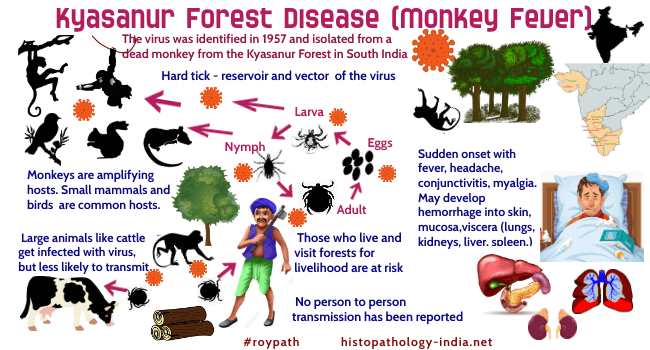|

Custom Search
|
|
Infectious Disease Online Pathology of Kyasanur Forest Disease (Monkey Fever) |

| Haemaphysalis
spinigera tick transmits Kyasanur Forest Disease Virus (KFDV), a
flavivirus that causes severe hemorrhagic fever with neurological
manifestations such as mental disturbances, severe headache, tremors, and
vision deficits in infected human beings with a fatality rate of 3-10%.
The disease was first reported in March 1957 from Kyasanur forest of Karnataka (India) from sick and dying monkeys. Since then, between 400 and 500 humans cases per year have been recorded; monkeys and small mammals are common hosts of this virus. |
|
Kyasanur Forest Disease (KFD) is caused by Kyasanur Forest Disease virus (KFDV) which is a highly pathogenic member in the family Flaviviridae, producing a haemorrhagic disease in infected human beings. In 1957, several dead monkeys were noticed in the Kyasanur forest in Shimoga district in Karnataka along with a severe prostrating illness in some of the villagers in the area. A new arbovirus, antigenically, related to the Russian spring-summer encephalitis complex of viruses was isolated by investigators from the Virus Research Centre, Poona, from patients and dead monkeys. It was named the Kyasanur Forest Disease virus after the name of the place from where the first isolations were made. Kyasanur Forest Disease has a sudden onset with fever, headache, conjunctivitis, myalgia and severe prostration. Some cases develop hemorrhages into the skin, mucosa and viscera. Case fatality rate is about five per cent. Outbreaks of the disease have occurred in the area periodically since it was first identified, but it has spread only for a few kilometers from the original site in all these years. Though human infection is usually found in certain areas in Karnataka, the virus appears to be more widespread in distribution as evidenced by KFD antibody in man and animals in the Kutch and Saurashtra peninsula and sporadically from other parts of India. Forest birds and small mammals are believed to be the reservoir hosts. Infection is transmitted by the bite of ticks, the principal vector being Haemaphysalis spinigera or contact with an infected animal like sick or dead monkey. An infection in monkeys leads to fatal disease, they are unlikely to be the primary reservoirs, but only amplifier hosts. Haemaphysalis ticks may act as the reservoir to some extent as transovarial transmission of the virus has been demonstrated in them. Gross and microscopic examination: - Non-specific disease process, with - Prominence of macrophages and lymphocytes in the liver and spleen, - Moderate parenchymal degeneration in the liver and kidneys and evidence of erythrophagocytosis in the spleen. - Hemorrhagic pneumonia - Several postmorem studies have found no abnormalities in the brain or spinal cord, while others have described cerebral edema or minimal infiltration of inflammatory cells. There are no clinical or laboratory findings indicating that encephalitis is a significant feature of Kyasanur Forest Disease. A formalin-inactivated, chick embryo fibroblast vaccine, developed in the early 1990s, is currently licensed and available in India. It is given in a two-dose schedule, followed by routine boosts. A variant of KFDV, characterised serologically and genetically as Alkhurma haemorrhagic fever virus (AHFV), was identified in Saudi Arabia . KFDV and AHFV share 89% sequence homology, suggesting common ancestral origin. Alkhumra virus infection, a new viral hemorrhagic fever in Saudi Arabia.
|
|
|

